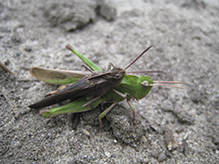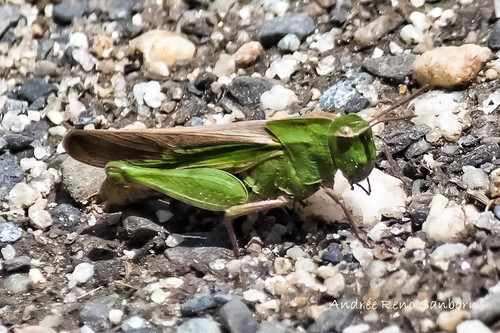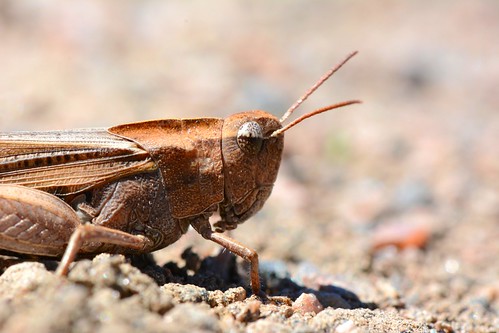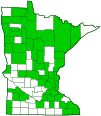green-striped grasshopper
(Chortophaga viridifasciata)
Conservation • Description • Habitat • Ecology • Distribution • Taxonomy
Conservation Status |
|
|||||||
| IUCN Red List | not listed |
|||||||
| NatureServe | N5 - Secure |
|||||||
| Minnesota | not listed |
|||||||
Description |
||
Green-striped grasshopper is a very common, medium-sized, early season, bandwing grasshopper. It occurs in the United States and southern Canada east of the Rocky Mountains. It is very common in Minnesota. Green-striped grasshopper is normally the first grasshopper to appear as an adult in the spring. Adults are found from early May, or as soon as the ground becomes warm, to mid-August in just about any grassy area, including hay meadows and roadsides. They feed on grasses and on some forbs. Female adults are robust, 1⅛″ to 1½″ (28 to 38 mm) in length. Males are more slender and smaller, ⅞″ to 1 3⁄16″ (23 to 30 mm) in length. The body is compressed, somewhat slender, and slightly hairy. There are two color forms, the green form and the brown form. The green form is mostly green with a small amount of brown. The brown form is entirely brown. The main difference is the color of the head, the thorax, and the outer face of the hind legs. Most but not all females are the green form, and most but not all males are the brown form. The upper part of the head (vertex) is horizontal when viewed from the side, triangular when viewed from above. On the male it is distinctly longer than wide. On the female it is about as long as wide. On the upper part of the forehead (fastigium) there is a shallow depression (foveola) on each side. The foveolae are very shallow, elongated, and triangular. The face is nearly vertical, only slightly slanted. The plate on the upper face (frontal costa) is prominent and rather narrow. It is only slightly narrowed above where it meets the vertex. There are three small simple eyes (ocelli), one below each foveola and one near the middle of the costa. The antennae are short, no longer than the head and the plate on the upper side of the thorax (pronotum) taken together. The pronotum is saddle shaped. On the upper side, the front margin is extended forward and broadly angled, and the rear margin is extended backward and triangular. It does not extend over the abdomen or beyond the base of the wings. There is a distinct longitudinal ridge (carina) in the middle. The carina is raised and sharply compressed. There is a single transverse groove (suculus) across the pronotum, that slightly cuts through the carina just before the middle. The lateral lobes of the pronotum are squared. The surface of the pronotum is rough and wrinkled. On the underside of the thorax there is no spur between the front legs. The forewings (tegmina) are leathery, narrow and long, extending beyond the tip of the abdomen. The front half is opaque and yellowish-brown. The rear half is membranous and grayish brown on the green form, dark smoky brown on the brown form. The hindwings are membranous and are folded fan-like when at rest. Unlike other bandwing grasshoppers, they are not obviously banded. The broad, black, outer band is present as a smoky area, and the yellow at the base is muted or sometimes absent. On the hind legs the third segment (femur) is medium-sized and long. On the male it extends beyond the abdomen, on the female it is slightly shorter than the abdomen. The outer face is green on the green form, brown on the brown form. It is not striped on either form. The upper face of the femur is pale and usually has three large dark spots. When viewed from above, the middle spot is triangular. The fourth leg segment (tibia) is brown or bluish green, with a broad whitish ring near the base. On all of the legs the end section corresponding to the foot (tarsus) has three segments. |
||
Size |
||
Female total length: 1⅛″ to 1½″ (28 to 38 mm) Male total length: ⅞″ to 1 3⁄16″ (23 to 31 mm) |
||
Similar Species |
||
Habitat |
||
Moist grassy fields |
||
Ecology |
||
Season |
||
One generation per year: early May to mid-August |
||
Behavior |
||
|
||
Life Cycle |
||
Nymphs overwinter |
||
Nymph Food |
||
Grasses and some forbs |
||
Adult Food |
||
Grasses and some forbs |
||
Distribution |
||||
|
Sources Haarstad, J. 1990. The Acrididae of Minnesota. Final report submitted to the Minnesota Department of Natural Resources. 28 pp. Hebard, Morgan. (1932). The Orthoptera of Minnesota. University of Minnesota. Minnesota Agricultural Experiment Station. Retrieved from the University of Minnesota Digital Conservancy, https://hdl.handle.net/11299/204015. Lugger, O. (1898). The Orthoptera of Minnesota. United States: McGill-Warner Company. |
|||
| 11/4/2023 | ||||
Occurrence |
||||
Very common in Minnesota |
||||
Taxonomy |
|||
Order |
Orthoptera (grasshoppers, crickets, and katydids) | ||
Suborder |
Caelifera (grasshoppers, locusts, and allies) | ||
| Infraorder | Acrididea (grasshoppers) | ||
Superfamily |
Acridoidea (short-horned grasshoppers and locusts) | ||
Family |
Acrididae (short-horned grasshoppers) | ||
Subfamily |
Oedipodinae (bandwing grasshoppers) | ||
Tribe |
Chortophagini | ||
Genus |
Chortophaga | ||
Subordinate Taxa |
|||
northern green-striped grasshopper (Chortophaga viridifasciata viridifasciata) southern green-striped grasshopper (Chortophaga viridifasciata australior) |
|||
Some authors treat the southern subspecies as a separate species Chortophaga australior. However, where they both occur, the characteristics of the northern and southern populations intergrade completely. In this area, determining the subspecies of an individual is unlikely, and determining where the range of each subspecies ends is impossible. For this reason, most authors treat the southern population as a subspecies. |
|||
Synonyms |
|||
Acridium hemipterum Acrydium marginatum Acrydium viridi-fasciatum Chortophaga meridionalis Chortophaga viridi-fasciatum Gryllus chrysomelas Gryllus virginianus Locusta infuscata Locusta radiata Tomonotus zimmermanni |
|||
Common Names |
|||
green-striped grasshopper green-striped locust |
|||
Glossary
Carina
An elevated keel or ridge.
Fastigium
On some insects, especially Orthoptera: the upper part of the forehead, between and often extending in front of the compound eyes.
Femur
On insects and arachnids, the third, largest, most robust segment of the leg, coming immediately before the tibia. On humans, the thigh bone.
Ocellus
Simple eye; an eye with a single lens. Plural: ocelli.
Pronotum
The exoskeletal plate on the upper side of the first segment of the thorax of an insect.
Tegmen
The modified, leathery front wing of grasshoppers and related insects that protects the hindwing. It may also serve as a camouflage, a defensive display, or a sound board. Plural: tegmina.
Tibia
The fourth segment of an insect leg, after the femur and before the tarsus (foot). The fifth segment of a spider leg or palp. Plural: tibiae.
Vertex
The upper surface of an insect’s head.
Visitor Photos |
|||||
Share your photo of this insect. |
|||||
| This button not working for you? Simply email us at info@MinnesotaSeasons.com. Attach one or more photos and, if you like, a caption. |
|||||
Crystal Boyd |
|||||
 |
|||||
MinnesotaSeasons.com Photos |
|||||
|
|||||

Slideshows |
||
| Northern Green-striped Grasshopper (Chortophaga viridifasciata viridifasciata Andree Reno Sanborn |
||
 |
||
| Chortophaga viridifasciata Andrew DuBois |
||
 |
||

Visitor Videos |
|||
Share your video of this insect. |
|||
| This button not working for you? Simply email us at info@MinnesotaSeasons.com. Attach a video, a YouTube link, or a cloud storage link. |
|||
Other Videos |
|||
| Green-striped Grasshopper (Chortophaga viridifasciata) - Now You See It Now You Don't Nature's Wild Things |
|||
About
Apr 20, 2017 Green-striped Grasshopper (Chortophaga viridifasciata) - Now You See It Now You Don't |
|||
| 20M Green-striped Grasshopper Chortophaga viridifasciata - exit left Tatamoc |
|||
About
Sep 18, 2023 Northumberland County, Ontario, Canada |
|||

Created: 11/4/2023
Last Updated:


